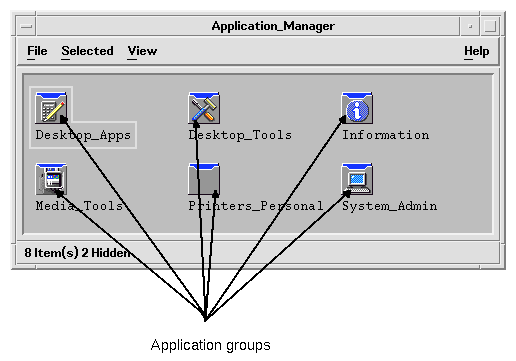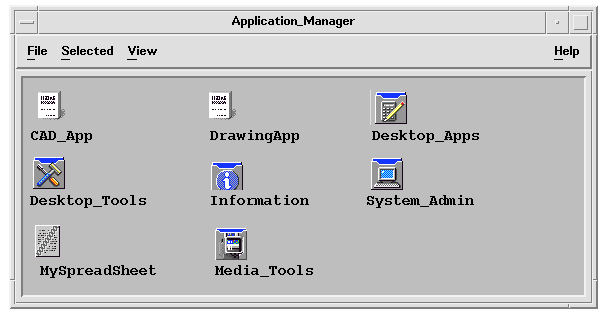Structure of Application Manager
The top level of Application Manager generally contains directories. Each of these directories, and its contents, is called an application group.
Figure 4–1 Application groups in Application Manager

The application groups and their contents are gathered from multiple locations locally and throughout the network.
Directory Location of Application Manager
In the file system, Application Manager is the directory /var/dt/appconfig/appmanager/login-hostname-display. The directory is created dynamically each time the user logs in.
For example, if user ronv logs in from display wxyz:0, the Application Manager directory /var/dt/appconfig/appmanager/ronv-wxyz-0 is created.
How Application Manager Finds and Gathers Applications
Application Manager is built by gathering local and remote application groups. The application groups are gathered from directories located along the application search path.
The default application search path consists of the locations shown in Table 4–1.
Table 4–1 Default Application Search Path Locations|
Scope |
Location |
|---|---|
|
Built-in |
/usr/dt/appconfig/appmanager/language |
|
System-wide |
/etc/dt/appconfig/appmanager/language |
|
Personal |
HomeDirectory/.dt/appmanager |
To create the top level of Application Manager, links are created at login time from the application groups (directories) located in directories on the application search path to the Application Manager directory /var/dt/appconfig/appmanager/login-hostname-display. The gathering operation is done by the desktop utility dtappgather, which is automatically run by Login Manager after the user has successfully logged in.
For example, the desktop provides the built-in application group:
/usr/dt/appconfig/appmanager/language/Desktop_Tools
At login time, a symbolic link is created to:
/var/dt/appconfig/appmanager/login-hostname-display/Desktop_Tools
The application search path can include remote directories. This provides a way to gather application groups from systems located throughout the network. For more information, see Adding an Application Server to the Application Search Path.
Precedence Rules in Gathering Applications
Where duplicates exist along the search path, personal application groups have precedence over system-wide groups, and system-wide groups have precedence over built-in groups. For example, if both /usr/dt/appconfig/appmanager/C/Desktop_Tools and /etc/dt/appconfig/appmanager/C/Desktop_Tools exist, the application group under /etc will be the one used.
Application Groups Provided with the Default Desktop
The uncustomized desktop provides four application groups.
-
Desktop_Apps
-
Desktop_Tools
-
Desktop_Controls
-
Information
-
System_Admin
Example of How Application Groups Are Gathered
Figure 4–2 shows an Application Manager window containing a variety of application groups. Table 4–2 shows the directories from which the application groups were gathered.
Figure 4–2 A Typical Application Manager Window
 Table 4–2 Source of Application Groups for a Typical Application Manager Window
Table 4–2 Source of Application Groups for a Typical Application Manager Window|
Name |
Directory Gathered |
|---|---|
|
CAD_App |
/net/ApServA/etc/dt/appconfig/appmanager/C/CAD_App |
|
DrawingApp |
/etc/dt/appconfig/appmanager/C/DrawingApp |
|
Desktop_Apps |
/usr/dt/appconfig/appmanager/C/Desktop_Apps |
|
Desktop_Tools |
/usr/dt/appconfig/appmanager/C/Desktop_Tools |
|
Information |
/usr/dt/appconfig/appmanager/C/Information |
|
OpenWindows |
/usr/dt/appconfig/appmanager/C/Information |
|
System_Admin |
/etc/dt/appconfig/appmanager/C/System_Admin |
|
MySpreadSheet |
/users/anna/.dt/appmanager/MySpreadSheet |
|
Media_Tools |
/etc/dt/appconfig/appmanager/C/Media_Tools |
If the Information or System_Admin application groups have been customized, they will be gathered from /etc/dt/appconfig/appmanager/C instead.
The CAD_App group is gathered because a system named ApServA has been added to the application search path (see Adding an Application Server to the Application Search Path). MySpreadSheet is a personal application group, available only to user anna.
- © 2010, Oracle Corporation and/or its affiliates
